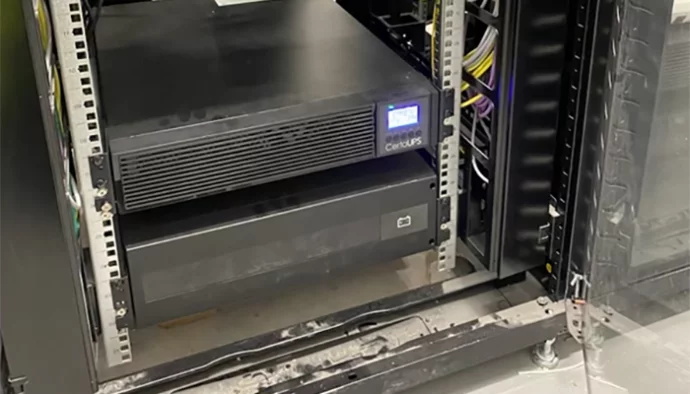A Guide to Buying A UPS Power Supply to Protect Your Critical IT Loads
At this time of year, it not uncommon to experience ‘blips’ in the mains power supply. Not surprisingly these may be caused by weather related factors such as storms and high winds or the electricity grid switching to cater for increasing demand. If you have a UPS power supply, you will be protected and may notice your UPS alarming for one or two seconds, as it uses battery power to keep your servers and IT loads running. If not, then you may have witnessed a sudden computer crash, server reboot or experienced storage device damage.
Any type of power fluctuation can cause wear and tear on the switch mode power supply built-into modern electronics devices, IT servers, storage devices and networking equipment. The only sure way to protect these critical loads and to provide sufficient ride-through battery backup is with an uninterruptible power supply or UPS power supply as it is sometimes referred to. Here are some of the key factors to consider when buying a UPS power supply.
Understanding UPS Power Protection Basics
An UPS system is a device that provides emergency power to a load when the input power source fails. The input power is either the local mains power supply or a standby power generator. The UPS as a power bridge between the main power source and the connected electronic devices and IT loads, offering a buffer against power interruptions. UPS power supplies typically consist of a battery, an inverter, and a charger component. The battery stores energy, the inverter converts DC power from the battery to AC power, and the charger recharges the battery when the main AC power source is restored.
How Much Power Do You Need?
The first step when embarking on a UPS project is to determine your power requirements accurately. Every critical load within a network should be assessed to determine if it needs UPS power supply protection. This includes computers, servers, storage devices, networking and monitoring equipment, and any other critical electronics. The power rating of a UPS is usually measured in Volt-Amperes (VA) or Watts (W). This information can be gathered from rating plates and manuals or more accurately assessed during a site power audit using devices that can inductively measure load sizes. It is important to choose a UPS size that can manage the total load with about 20% headroom for future load expansion.
3 Types of UPS
There are three main types of uninterruptible power supply, and each offers a different grade or level of power protection. Both when the main power source is present, and when using stored battery energy. There are three main types of UPS systems: standby, line-interactive, and online (double-conversion).
- Standby UPS: ideal for protecting personal computers and home electronics, standby UPS systems switch to battery power only when the main power source fails and provide limited protection when the main power source is present from sags, surges, spikes and electrical noise.
- Line Interactive UPS: : suitable for small to medium-sized businesses and their computers and server loads. Interactive UPS systems provide voltage regulation (via a built-in automatic voltage stabiliser or regulator) and battery backup. They provide protection against power a higher level of power fluctuation protect than a standby or offline UPS and a superior inverter output waveform.
- Online (Double-Conversion) UPS: designed for critical IT server applications including telecoms, data centers and server rooms online UPS power supplies provide the highest grade of power protection, both when the mains power source is present and when it fails. The inverter is constantly powering the load with a digitally generated sinewave. A built-in automatic bypass routes the connected load(s) to the main power source if the UPS is overloaded or suffers and internal fault. The online UPS therefore provides a safe-failure-to-mains mode that is not present in line interactive or standby power UPS.
A key indicator of the type of UPS technology is price. The higher the grade of power protection provided, the higher the price. Also, within specification documents, the type of technology should be specified alongside inverter transfer times and output waveforms, especially important when considering offline or line interactive UPS.
Battery Runtime and Battery Types
Runtime is a measure of the duration or amount of time that an uninterruptible power supply can run on battery power during a power outage. This is typically measured in minutes and is a function of the battery Ampere-hour (Ah) installed and the connected load. The lower the load, the longer the UPS runtime. For this reason, it is important to oversize a UPS power supply and select a runtime that is long enough to either ride through a power outage and/or provide sufficient battery support time to initiate and complete an orderly load shutdown.
It is also important to consider the type of battery used. The two most common battery types include sealed lead-acid (SLA) and lithium-ion (Li-ion). SLA batteries are cost-effective and suitable for most standby applications. Over 90% of UPS use a version of lead acid battery referred to as Valve Regulated Lead Acid (VRLA) batteries. This type of battery has a 5 or 10year design life and is maintenance free. Lithium-ion batteries provider a longer working life than VRLA batteries, a higher energy density and faster recharge time but at a premium of around 30% compared to lead acid.
Voltage Regulation and Power Problem Mitigation
Most mains power supplies experience some form of power pollution. This can be in the form of sags, surges, brownouts, spikes, and electrical noise, and even harmonics. The AC voltage is constantly changing as can be the frequency. All within bands of tolerance but the wider the variances, the harder the power supplies within your loads must work.
It is important to consider power pollution as much as it is the amount of battery power required. The three distinct types of UPS discussed offer various levels if mains present power protection. Standby UPS (also referred to as off-line) offer the least protection, with online UPS offering the most. The higher the level of protection provided, the higher the cost but the lower the changes of a critical load being damaged by a fast electrical spike caused by a nearby lightning strike or electrically noisy load connected to the same AC ring circuit.
Scalability and Expandability
How will your load change over the next 3 to 5 years? IT infrastructure is constantly changing and systems refreshed. Allow sufficient load expansion in your choice of UPS size. This allows you to add more load over time. For online UPS you could considered a modular UPS system. This is one that allows additional modules to be connected to scale the power kVA (or kW) upwards and/or provide N+1 resilience and redundancy. The more flexible the UPS technology, the higher the cost in the short term but overall, oversizing or going for modular can save costs over time. You may also want to consider battery runtime as part of this in terms of adding additional battery packs later.
UPS Management and Monitoring
Remote management and monitoring capabilities are essential to ensuring the overall health of your UPS power source and for picking up alarm conditions. Most UPS provide interface ports or additional cards (e.g. SNMP, volt-free signal contacts, Profibus or Modbus/TCP) for connection not remote monitoring UPS software, third-party monitoring and building management systems (BMS). A UPS can also initiate orderly IT computer or server shutdown for those networks running an appropriate UPS management tool or software package.
Form Factor and Installation Environment
The form factor of a UPS refers to its physical size and shape. UPS systems come in various form factors, including tower, rackmount, and compact desktop models. Choose a form factor that suits your available space and installation requirements. Rackmount UPS units are popular for server rooms and data centers, while tower models are suitable for office environments and home use.
For server rack installation, consider the amount of U-height that the UPS will take within the server cabinet and the depth of cabinet required. If you have multiple battery packs, these will add to the amount of U-height required.
From a temperature point of view, it is important that the UPS environment is within 20-25°C to protect the batteries (lead acid). The higher the temperature, the greater the battery performance in terms of runtime minutes provided on mains power supply failure, but the shorter the working life.
Reliability and Warranty
Reliability is a critical factor when selecting a UPS, as it directly impacts the protection of your valuable electronics and computer loads. Online UPS provide the greater protection and reliability but when selecting a UPS, it is also important to consider the warranty period (typically 2-5 years) provided by the UPS manufacturer and supplier and their support package. Onsite maintenance contracts should be available for larger UPS systems with annual preventative maintenance and technical support.
Energy Saving Considerations
Most modern UPS are very efficient and can achieve up to 95% or greater in terms of electrical energy efficiency. This lowers their running costs and adds less to the local air conditioning mode. Some online UPS have an ‘eco’ mode that puts them into line interactive or standby mode. Whilst this offers energy savings, it does lower the level of power protection provided. Eco mode can be considered for periods of low activity, if ever possible.
Budget Considerations
How much are you looking to pay? It is important to size UPS power source for your load today and allow for expansion. The extra features you need can include interface cards, additional battery runtime and an external maintenance bypass. A UPS maintenance contract (or extended warranty) should also be considered. All these factors affect the overall budget required for your investment which should be weighed up against how critical the IT loads to protect are to your organisation. Downtime typically results in lost revenue, data loss or data corruption, impacts service delivery and customer satisfaction.
Business Continuity Planning
Most organisations must consider the impact of power outages on their ability to continue operations as part of their business continuity planning, especially in relation to ISO27001, the information management system standard.
A power outage lasting several hours can impact the ability of an organisation to consider operations. Server loads are either kept running during this period or gracefully shutdown. The latter forcing the organisation to resort to backup systems. In terms of business continuity, the right UPS power system in place helps to mitigate the impact of a power outage or longer duration power cut.
Summary
Investing in a UPS power supply is an investment in the reliability and continuity of your critical IT loads and electronic devices. By understanding your power protection needs, selecting the right type of UPS power supply, and considering factors such as runtime, voltage regulation, and scalability, you can make an informed decision. It is important to prioritise what matters most for your installation, choose the right package and features and factor these into your budget. Careful selection of the right UPS power system to protect your application(s) will ensure uninterrupted operation and mitigate against the impact of power outages and fluctuations.

























